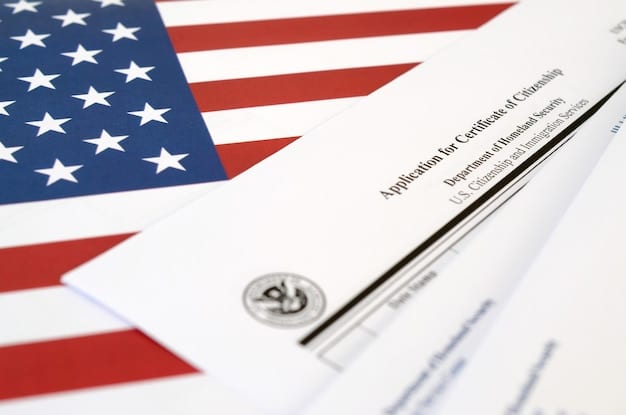Music Copyright Law for Emerging Artists: Protect Your Work

Emerging artists must understand music copyright law to protect their original work, avoid infringement issues, and secure their rights, ensuring they receive proper credit and royalties for their creative efforts.
Navigating the world of music as an emerging artist is exciting, but it’s also crucial to understand the legal landscape. Emerging artists: Understanding music copyright law – avoid costly mistakes and protect your work is essential for safeguarding your creative output and ensuring you receive due recognition and compensation.
Understanding the Basics of Music Copyright Law
Copyright law protects original musical works, including compositions and sound recordings. For emerging artists, grasping these basics is the first step in ensuring their creations are protected and their rights are respected.
Let’s delve into what copyright entails and how it applies to your music.
What is Copyright?
Copyright is a legal right granted to the creator of original works, including musical compositions and sound recordings. It gives the copyright holder exclusive control over the use of their work, including the right to reproduce, distribute, perform, display, and create derivative works.
- Originality: The work must be original and not copied from another source.
- Fixation: The work must be fixed in a tangible medium of expression, such as sheet music or a recording.
- Protection: Copyright protection begins automatically upon creation and fixation.
Key Components of a Musical Work
A musical work has two primary components, each with its own set of protections:
- Musical Composition: This includes the melody, harmony, and lyrics of a song. Copyright for the composition is typically owned by the songwriter or publisher.
- Sound Recording: This is the actual recording of the song. Copyright for the sound recording is usually owned by the performer or record label.
Understanding these components is crucial. For example, even if you write a song, you might not own the rights to a particular recording of it if you didn’t produce that recording yourself.

The Importance of Registering Your Copyright
While copyright protection is automatic, registering your work with the U.S. Copyright Office provides significant legal advantages. For emerging artists, registration is a proactive step toward protecting their music and their livelihood.
Here’s why registering your copyright is essential.
Benefits of Copyright Registration
- Public Record: Registration creates a public record of your copyright claim.
- Legal Recourse: You can file a lawsuit for infringement and recover statutory damages and attorney’s fees.
- Evidence of Ownership: Registration serves as evidence of ownership if a dispute arises.
- International Protection: Registration can help you enforce your rights in other countries through international agreements.
How to Register Your Copyright
Registering your copyright is a straightforward process:
- Create an Account: Visit the U.S. Copyright Office website and create an account.
- Complete the Application: Fill out the online application form, providing details about your work.
- Submit Your Work: Upload a copy of your musical composition or sound recording.
- Pay the Fee: Pay the required registration fee.
Once your application is processed and approved, you will receive a certificate of registration, confirming your copyright.

Avoiding Copyright Infringement: Fair Use and Licensing
Copyright infringement occurs when someone uses your work without permission, violating your exclusive rights. Emerging artists must be vigilant about protecting their own work and avoiding infringing on others’ copyrights.
Understanding fair use and licensing can help you navigate these issues.
Understanding Fair Use
Fair use is a legal doctrine that allows limited use of copyrighted material without permission for purposes such as criticism, commentary, news reporting, teaching, scholarship, or research. However, determining whether a particular use qualifies as fair use can be complex.
Key factors in determining fair use include:
- Purpose and Character of the Use: Is the use transformative (i.e., does it add new expression or meaning)?
- Nature of the Copyrighted Work: Is the work factual or creative?
- Amount and Substantiality of the Portion Used: How much of the work was used?
- Effect of the Use on the Market for the Original Work: Does the use harm the market for the original work?
Licensing Your Music
Licensing allows you to grant permission for others to use your music in exchange for compensation. There are several types of licenses relevant to emerging artists:
- Mechanical Licenses: These licenses allow someone to reproduce and distribute your song on CDs, records, or digital downloads.
- Performance Licenses: These licenses grant the right to publicly perform your song, either live or through broadcasting.
- Synchronization Licenses: These licenses allow someone to use your song in a film, TV show, or video game.
Monetizing Your Music: Royalties and Revenue Streams
As an emerging artist, understanding how to monetize your music is essential for building a sustainable career. Copyright law plays a crucial role in ensuring you receive royalties and other forms of compensation for your work.
Let’s explore the various revenue streams available to musicians.
Types of Royalties
There are several types of royalties you can earn as a musician:
- Mechanical Royalties: These are paid when your song is reproduced and distributed.
- Performance Royalties: These are paid when your song is performed publicly.
- Synchronization Royalties: These are paid when your song is used in a film, TV show, or video game.
- Digital Performance Royalties: These are paid when your song is streamed online, such as on Spotify or Apple Music.
Collecting Your Royalties
To collect your royalties, you can affiliate with performing rights organizations (PROs) such as:
- ASCAP (American Society of Composers, Authors, and Publishers)
- BMI (Broadcast Music, Inc.)
- SESAC (Society of European Stage Authors and Composers)
These organizations track public performances of your music and distribute royalties to songwriters and publishers.
Collaborating with Other Artists: Joint Ownership
Collaboration is a common and often rewarding aspect of being a musician. However, it’s crucial to understand how joint ownership of copyright works when collaborating with other artists.
Here’s what you need to know about joint ownership and collaborative agreements.
What is Joint Ownership?
Joint ownership occurs when two or more individuals contribute to the creation of a musical work with the intention that their contributions be merged into inseparable or interdependent parts of a unitary whole. Each joint owner has equal rights to exploit the work, subject to a duty to account to the other owners for any profits.
Key considerations for joint ownership:
- Intent: There must be an intent to create a joint work.
- Contribution: Each collaborator must contribute something copyrightable.
- Agreement: It’s best to have a written agreement outlining each collaborator’s rights and responsibilities.
Protecting Your Brand: Trademarks and Artist Names
In addition to copyright, trademarks can play a vital role in protecting your brand as an emerging artist. A trademark is a symbol, design, or name legally registered to represent a company or product.
Here’s how trademarks can help you protect your artist name and brand.
Why Trademark Your Artist Name?
- Exclusivity: A trademark gives you exclusive rights to use your artist name in connection with your music.
- Protection: It prevents others from using a similar name that could cause confusion among fans.
- Licensing Opportunities: You can license your trademark to others for merchandise and endorsements.
How to Trademark Your Artist Name
The process of trademarking your artist name involves several steps:
- Search: Conduct a search of the U.S. Patent and Trademark Office (USPTO) database to ensure your name is available.
- Application: File an application with the USPTO.
- Examination: The USPTO will examine your application to ensure it meets the requirements.
- Publication: If approved, your trademark will be published in the Official Gazette.
- Registration: If no oppositions are filed, your trademark will be registered.
Conclusion
Navigating music copyright law can seem daunting, but it’s essential for emerging artists to protect their work and build a sustainable career. By understanding the basics of copyright, registering your work, avoiding infringement, and exploring licensing opportunities, you can safeguard your creative output and ensure you receive proper recognition and compensation. Collaborating with other artists requires careful consideration of joint ownership agreements. Additionally, trademarks can help protect your brand and artist name. Equipped with this knowledge, you can navigate the music industry with confidence, protect your rights, and focus on creating great music.
Key terms
Brief Explanation
Copyright Registration
Protects creative works
Royalties
Payment for legal use of copyrighted materials
Intellectual Property
The legal rights which result from intellectual activity in the industrial, scientific, literary and artistic fields
Fair-Use Doctrine
Allows the use of copyrighted works without permission under certain circumstances.
“`html
Frequently Asked Questions
▼
Copyright infringement occurs when someone uses a copyrighted musical work without permission, violating the owner’s exclusive rights to reproduce, distribute, perform, display, or create derivative works.
▼
You can license your music through various types of licenses, such as mechanical licenses for reproduction, performance licenses for public performance, and synchronization licenses for use in films or TV shows.
▼
Joining a PRO like ASCAP, BMI, or SESAC allows you to collect performance royalties for public performances of your music, which are otherwise difficult to track and collect on your own.
▼
Yes, but you typically need to obtain permission from the copyright owner of the sampled work. Failure to do so can result in copyright infringement and legal repercussions.
▼
Fair use allows limited use of copyrighted material without permission for purposes such as criticism, commentary, news reporting, teaching, scholarship, or research. However, determining fair use can be complex.
“`html
Conclusion
Understanding music copyright law is essential for emerging artists to protect their work and build a sustainable career. By grasping the basics of copyright, registering your work, avoiding infringement, and exploring licensing opportunities, you can safeguard your creative output and ensure you receive proper recognition and compensation.
“`html
Emerg Artists





